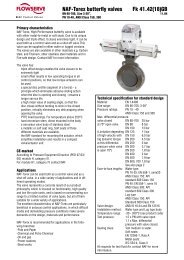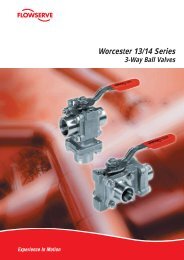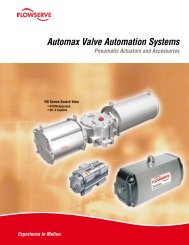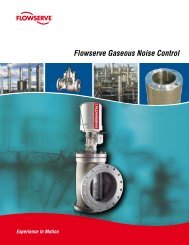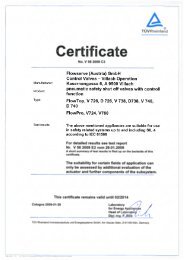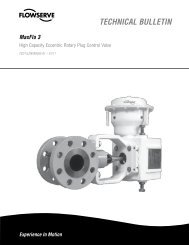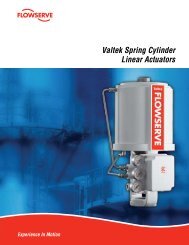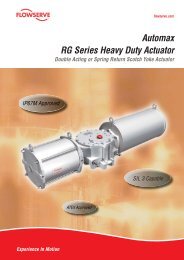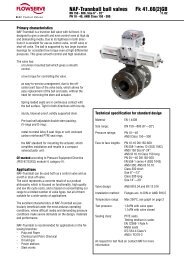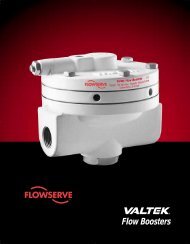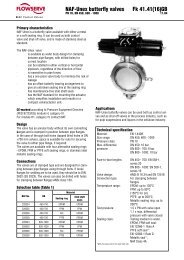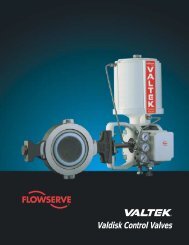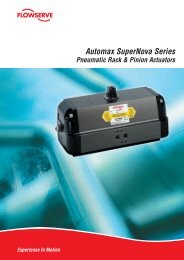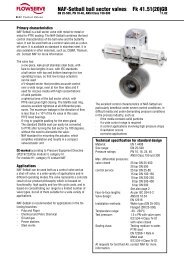<strong>Valtek</strong> <strong>Severe</strong> <strong>Service</strong> <strong>Equipment</strong>IntroductionIf this same valve operates wide open at an upstreampressure (P 1) of 500 psia and a downstream pressure(P 2) of 200 psia, and the water temperature increasedto 180° F (vapor pressure = 7.5 psia), the operatingSigma is:σ operating= (500 - 7.5) = 1.64(500 - 200)Because this Sigma value is greater than σ choked, thevalve is not choked at these conditions. However, theSigma is less than σ damage; therefore, the valve mayexperience cavitation damage unless special anticavitationtrim or harder materials are used.Some of the other factors that affect the intensity ofcavitation are the magnitude of the actual service pres-sure compared with test pressures, the flow path geometryand the fluid purity. By researching these factors,methods of scaling the index for such variables havebeen established. This geometry and pressure scalingis not accounted for in the use of liquid pressure recoveryfactor (F L) and liquid cavitation factor (F i) in previousvalve sizing equations.Globe valves experience minimal cavitation damagewhen operating at low pressure (Sigmas between 2and 1.7). Generally, in these cases, no cavitation controltrim is necessary. However, at between Sigma 1.7 and1.15, some cavitation control is usually required. Whenthe Sigma index for a valve is less than 1.15, thepotential for severe cavitation damage exists and astaged pressure drop severe service trim must beincluded in the valve’s sizing.Table 1: <strong>Valtek</strong> Trim Solutions to Cavitation Associated with Control ValvesGlobe-styleTrimTiger-ToothChannelStreamMicroCavCavControlDesignStackof expanding teeth discsCartridge or plug with cylindersusing intersecting channelsPlugwith expansion groovesDiametricallyopposed jetsTo eliminateformationApplicationor minimize cavitationTo eliminate or minimize cavitationformationTo eliminate or minimize cavitationformation in low flow servicesForSigmasapproaching1.002SeePages6 - 91.00210 - 141.00415Toeliminate or minimize cavitation damage1.1516 - 18GASEOUS SEVERE SERVICESIn gas services, noise is generated by high pressuredrops across the valve and by subsequent turbulencedownstream. As a direct result, noise is radiated to thesurrounding area by the downstream piping system(Figure 7). In situations where equipment damage orpersonal injury could be caused by a noise source, noiseattenuation is not only desired, it is mandatory.With gases, superimposing a velocity profile on thepressure profile (Figure 2) reveals the main componentin control valve noise generation. For single throttlingpoint control valves, because of the sharp pressurereduction at the vena contracta, the velocity is greatlyincreased. Tests have demonstrated that a control valve’ssound pressure level increases proportional to the velocitycubed (SPL ~ V 3 ). Noise is generated as velocitiesin the valve increase and substantial noise can begenerated even where velocities are significantly lessthan sonic.OSFigure 7: Downstream Turbulence Causedby Vena Contracta in a Valve4Flowserve Corporation, <strong>Valtek</strong> Control Products, Tel. USA 801 489 8611
<strong>Valtek</strong> <strong>Severe</strong> <strong>Service</strong> <strong>Equipment</strong>IntroductionHigh mechanical vibration levels accompany high acousticnoise levels. Acoustic noise and mechanical vibrationlevels are greatly compounded (up to 50 times) when thefrequency of the excitation matches acoustic and/ormechanical natural frequencies of the system.Noise suppression trim (source treatment) shouldalways be considered in any high energy (high pressure,high flow) and/or resonant noise/vibration applications.The solution to high levels of control valve noise is toreduce the pressure from the valve inlet to outlet gradually,avoiding the effects of a large pressure drop at anyvena contracta (Figure 5). Thus, for gases, velocities aremaintained at acceptable levels throughout the valveand high noise levels are not generated. This requiresnot only controlling the gas velocity through the valvetrim but at all points from the inlet to the outlet of thevalve.Several of the following factors must be consideredbefore expensive noise suppression equipment is chosen:How much noise attenuation is actually required?What are the low or no-cost alternatives to noise attenuation?If noise attenuation devices are necessary, whatlower-cost equipment can be specified?If the predicted sound pressure level (SPL) exceeds 85or 90 dBA, noise suppression devices should be considered.However, higher noise levels may be acceptableif the noise is not associated with equipmentdamage and is located in a remote location away frompeople. Other possible low-cost alternatives to noisesuppression equipment are: (1) insulating the pipe, (2)locating the valve discharge directly into a vessel (allowingthe noise to be absorbed by the vessel), (3) relocatingthe noise source (such as the downstream piping)outside an enclosed area, (4) reversing the flow directionthrough the valve, or (5) reducing the pressure dropacross the valve.The P 1/P 2Ratio IndexWhen excessive sound pressure levels are encountered,special trim must be used to attenuate the noise level.<strong>Valtek</strong> severe service trim can be installed in globe- andangle-style control valves for use in noise reduction andshould be used when a maximum sound attenuationof up to 30 dBA is needed. To establish the designrequirements for such trim, Flowserve engineers use aP 1/P 2ratio, along with other factors, to determine theseverity of noise in an application. To obtain the maximumnoise reduction for any trim, the service P 1/P 2ratiomust be less than the maximum P 1/P 2ratio listed foreach trim design and size. These ratios can be foundin the tables for each noise attenuating trim describedin this literature.Table 2: Flowserve Solutions to Gaseous Noise Associated with ValvesGlobe-style Trim /Downstream DeviceDesignSPL ReductionSee PagesTiger-ToothTrimMegaStream TrimExpandingteethMulti-holetrimUpto 30 dBA4 - 7Upto 28 dBA19 - 251MegaStream Plate Downstream multi-hole resistance plate1MegaStream Diffuser Downstream multi-hole diffuser1MegaStream Silencer Downstream In-line silencerUpto 15 dBA26 - 27Upto 15 dBA28 - 29Upto 30 dBA30 - 31Tiger-ToothVent ElementExpandingteeth ventUpto 30 dBA321Any one of these downstream noise reduction devices in series with a valve can be selected to attenuate noise to the acceptableSPL required. For example, a MegaStream plate or diffuser, when installed downstream from a standard <strong>Valtek</strong> control valve,provides about the same dBA reduction as a one or two-stage MegaStream valve, but at a lower cost. For extremely highpressure drops where multi-stage valve trim may be considered, a cost-effective option may be to install a MegaStream plate,diffuser or silencer downstream from a smaller one or two-stage MegaStream valve.Flowserve Corporation, <strong>Valtek</strong> Control Products, Tel. USA 801 489 86115



